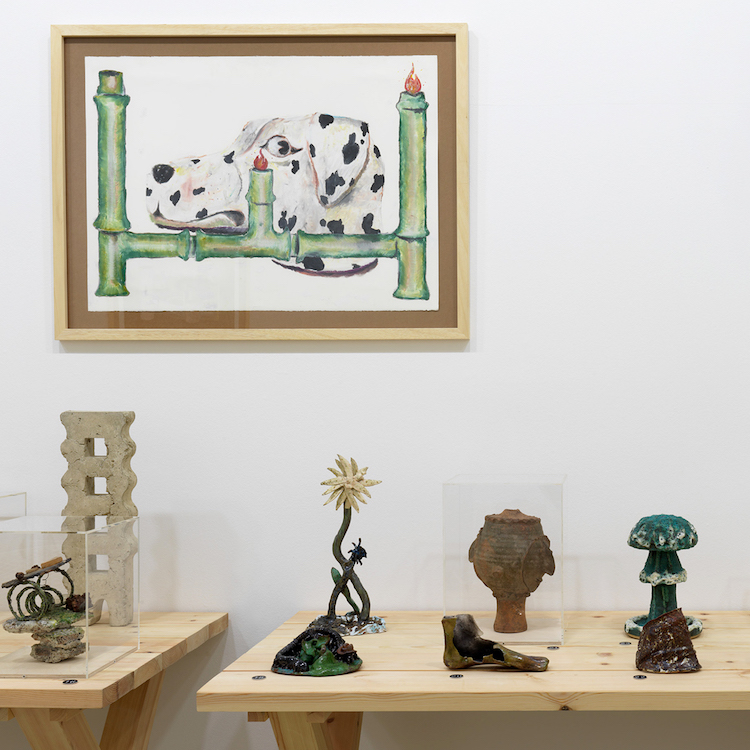All this week, we’ll be showcasing all things British Ceramics from the world of contemporary ceramics and contemporary ceramic art. Due to the field of British Ceramics’ incredible and vigorous expansion over the years, we felt it was important to highlight some of the major players and their achievements. Enjoy!
ST IVES—One might consider Yale’s Things of Beauty Growing somewhat slick (I would argue sleek) compared to the Tate’s scruffy, That Continuous Thing: Artists and the Ceramics Studio, 1920-Today (St Ives, 31 March – 3 September 2017) but is more cohesive and intellectually a step above. (Is there an esoteric “things” meme for ceramics exhibitions I am unaware of, there have been a number this year?)
St Ives offers an undigested catch all, a grab bag from Britain, America and Japan, exploring 100 years of ceramics with over 140 works from 50 artists but with nebulous criteria. Yale makes it clear that theirs is an exhibition of studio pottery. There is a consistent vision that hardly wavers, St Ives goes anywhere clay travels. And the claim to it being art is thin in some patches. It is indeed a treat in terms of things ad was worth seeing, but there is no convincing final thesis.
Continuity’s substitute for scholarly vision is “its all clay”. Will we ever grow out of this puerile view that all ceramics belong together no matter how disparate because a kiln was involved in their creation? Maybe not. But placing Jesse Wine’s art, which I admire, with Bernard Leach so, so misses the point.

Jesse Wine I think you ought to know, I’m going through a creative stage some people find easy to connect to, 2016, Courtesy Mary Mary, Glasgow
When Wine plays with studio pottery it is as an outsider, a critic not a member. And instead of showing his riveting and hilarious recent transformations of Voulkos, Price and Autio, (see review) all of whom has pieces on show, a purely figurative work has been selected, missing the opportunity for him appear as a satirist of the movement. And I might note that none of three American’s liked Leach as a potter, but did respect as an academic.
The St Ives show could also have been retitled Night of the Living Dead as Leach rises from his kiln to lurch through this gathering dropping dead clay in his wake. He has been doing that a lot recently. It happens at Yale too but it is handled better. Although, I must say that the pots by Leach were vastly superior to those in New Haven.
Scholars can’t seem acknowledge that William Staite Murray was the father of modern studio pottery not Leach. The key is the term “modern”. Leach was a narrow, bigoted, academic, historicist and a generally mediocre potter with some high moments but they were not consistent. If I have any animus towards this man it is not personal, our contact during his life was limited was cordial and he was generous. It exists because I have long tracked the history of Leach trying to block the growth of a truly 20th century ceramics movement. He was no friend of his contemporary times.
Even his apprentices Michael Cardew and Katherine Pleydell-Bouverie, would sneak away concealing from Leach that they were attending latest exhibitions in London by his nemesis, Murray. He was their God. Leach was their teacher.
St Ives is a difficult position. It is like being the Church of St Patrick. It can hardly take a negative view of St Paddy. The patron saint must be worshipped. So historical exhibitions from this source will always have the bias of being Leach’s home. On the other hand, when floating free without Leach as an anchor, Tate St Ives has been a great champion of contemporary ceramics in art adding their lofty imprimatur to their efforts.
Garth Clark
Related reads:
http://cfileonline.wpengine.com/exhibition-yale-center-for-british-art-things-of-beauty-growing-is-a-sparkling-gem/
http://cfileonline.wpengine.com/design-matteo-cibics-ceramic-menagerie-of-utopian-organisms/
http://cfileonline.wpengine.com/exhibition-vases-vessels-chance-encounters-material-earth-in-brief-three-british-ceramics-exhibitions/
http://cfileonline.wpengine.com/architecture-kent-countryside-peg-tile-house-wins-2017-riba-house-of-the-year/
Do you love or loathe this exhibition from the world of contemporary ceramic art and contemporary ceramics? Let us know in the comments.








Add your valued opinion to this post.